Age is an undeniable factor in training and sports performance, but the accumulating years don’t have to spell the end of your major athletic pursuits. Aging climbers can still pursue big goals in the sport.
Take it from Coach Eric Hörst, who recently turned 60 – in the past year he climbed one of his hardest routes (Kaleidoscope 5.13c), and he maintains nearly the same amount of strength he possessed at age 30.
But Hörst isn’t delusional. He’s learned that age comes with struggles that you can’t just ignore. In fact, it’s his proactive embrace of getting older that has given him the ability to continue training – and climbing – hard, well past the point when most of his peers have taken a knee.
Hörst pays careful attention to what his body needs to function optimally at age 60 rather than stubbornly continuing to act like he’s still 25. Putting in the work it takes to stay active, recover well, prevent injuries, and keep energy and motivation levels high might take more effort than it did a few decades ago, but it’s the key to maintaining the high-achieving athletic lifestyle that he loves. That’s worth every sacrifice in his eyes.
“There’s more leeway when you’re young,” Hörst explains. “You can be more flexible with your diet, take fewer rest days, and frequently burn the candle at both ends, but as an older athlete you simply have to take greater surveillance of your dietary, recovery, training habits, and total aggregate load on your body.”
As he reflects on the new milestone this birthday brings, Hörst’s proactive approach as an aging climber is comprised of six distinct focal points that have helped him slow down the aging process. Consider this the essential guide to climbing strong as an older athlete. Whether you’re into your seventh decade like Hörst or approaching 40, you will benefit from taking his tips on self-care for sustainable athleticism to heart.
Collect Data
Start off by figuring out what your body needs in the first place. No two bodies have the same needs, and even your own body needs different treatment today than it did yesterday, last season, or ten years ago. Hörst recommends that older athletes commit to collecting more data about their bodies so they can understand – and act – on what’s really going on.
“At the very least,” Hörst urges, “get an annual physical and consider getting bloodwork as frequently as every quarter. Things like hormones, inflammatory markers, red blood cell count, vitamin D status, and thyroid function all change as you get older…and generally move against you. Having a track record of results will empower you to take countermeasures via training load, rest, dietary habits, supplements, and pharma, if necessary.
Hörst also started wearing a Whoop strap to provide additional daily biomarkers relating to strain, heart rate, sleep quality, HRV, among other things. The data it offers helps him understand the impact of these variables and motivates him to work on the habits he struggles with most, like sleep. As a small business owner, Hörst often finds himself burning the midnight oil a little too frequently for his own good. Seeing the negative effect of those long work days (combined with his training strain) on health data was just the nudge he needed to put more effort into smart sleep habits.
Address Injuries
“The body of a Masters athlete is more fragile than in one’s formative days,” Hörst emphasizes. While he yearns for his younger years when minor aches would disappear overnight, he accepts the new normal of frequent morning stiffness and pangs as an aging climber, and he takes disciplined daily action to address the issue(s) du jour.
Hörst admits that “if I waited until every ache and pain went away completely then I would never train.” It’s more about discerning what’s normal for an aging athlete versus what needs extra TLC. He uses rate of onset as one point of differentiation. If low-grade discomfort comes on slowly under the weight of a major training block, like backaches or elbow tenderness, he treats it as a caution sign that could use a little care but won’t put a stop to his training. Alternatively, he treats higher-grade pains that come on quickly as more of a stop sign for training/climbing, and he’s quick to seek medical care for an accurate diagnosis as an aging climber rather than the wait-and-see approach common among younger athletes.
Deload Frequently
Every three or so weeks of hard training or climbing, Hörst takes a deload week. Deload weeks are important for athletes of all ages for recovery from heavy training loads and injury avoidance, although in his younger days, he might have taken one deload week every two months. He’s noticed that as an aging climber, “my body needs more downtime to catch up and reset after working hard for several weeks in a row.” Hörst adds, “If I go longer than three or four weeks without a deload, I accumulate such a deep level of fatigue that it can take weeks to recover from.”
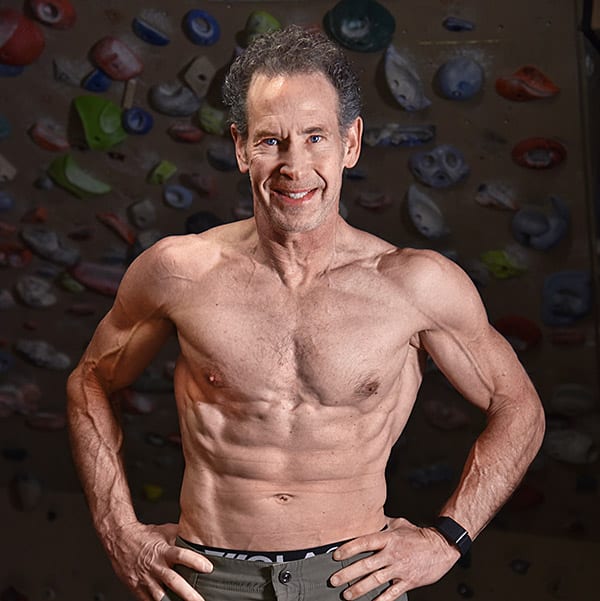
Eric Hörst age 60 — fighting Father Time!
Prioritize Protein
Protein is another important aspect of recovery and resilience that athletes of all ages should care about. Aging climbers, however, need to make protein consumption even more of a priority. “As you get older you become more catabolic than anabolic,” Hörst notes, “so you’re breaking down more than you’re building back up. By increasing daily protein intake you juice anabolism, thus supporting muscle mass and strength rather than succumbing to sarcopenia (age-related muscle and strength loss).”
Synthesis of collagen also slows down every year after age 30, which means not only the onset of skin wrinkling but also the gradual stiffening of connective tissues and slower remodeling of tendons after a bout of stressful exercise. Tendon ruptures, most frequently the biceps and Achilles but possibly elsewhere, are more common among both weekend warriors and professional athletes as they progress through their 30s, 40s, and 50s.
That’s why Hörst recommends consuming a minimum of 100 grams of protein per day for the aging climber, and much more on especially stressful training days. A good guideline is 0.7 to 1.0 gram of protein per pound of body weight per day. If that sounds like a lot, it is—which is why Hörst gets his from a combination of whole food protein sources and protein supplements like PhysiVāntage Weapons Grade Whey and Supercharged Collagen. Supplemental protein is an efficient way to meet your protein target without consuming too many calories that may lead to unwanted weight gain.
Stay Active, Stay Loose
Rest days are important. But what’s more effective on those days than complete rest is active recovery. Coach Hörst strives to do something physical every day that will elevate his heart rate and promote healthy mitochondria. He’s clear that “I’m not talking about exhaustive training or high-intensity activity every day.” It’s best to limit those high-intensity workouts to just a few sessions throughout the week complemented by a higher volume of low- and moderate-intensity training (eg. jogging, rowing, hiking, submaximal climbing, easy lifting, and such). But even on his rest days from structured activity, Hörst feels best when he activates his muscles and moves his joints. Toward this end, he’s fond of taking midday walks in the sunshine, and he begins and ends each day with a bit of foam rolling and stretching.
Set Goals That Motivate!
Staying motivated is the lynchpin of Hörst’s success strategy for aging climbers. He states emphatically, “Without a vivid, compelling goal(s) in mind, it’s really hard to stay energized and on-program – there are just too many distractions (people, media, and time-wasting activities) tempting to pull you off course.”
For Hörst, motivation as an aging climber comes from setting both process and performance goals, and always having something to shoot for this week, next month, and even next year. This gives all of the effort he puts into the process more meaning because everything supports progress toward both a near-term and long-term goal.
Related Articles:
- Age is (Mostly) a State of Body
- How Coach Eric Hörst Sent Kaleidoscope (13c) After Injury
- Manage Fatigue and Accelerate Recovery
- Eric Hörst on Training for Climbers Over Age 35
- How Much Does Age Really Matter?
Copyright © 2000–2024 Lucie Hanes & Eric J. Hörst | All Rights Reserved.

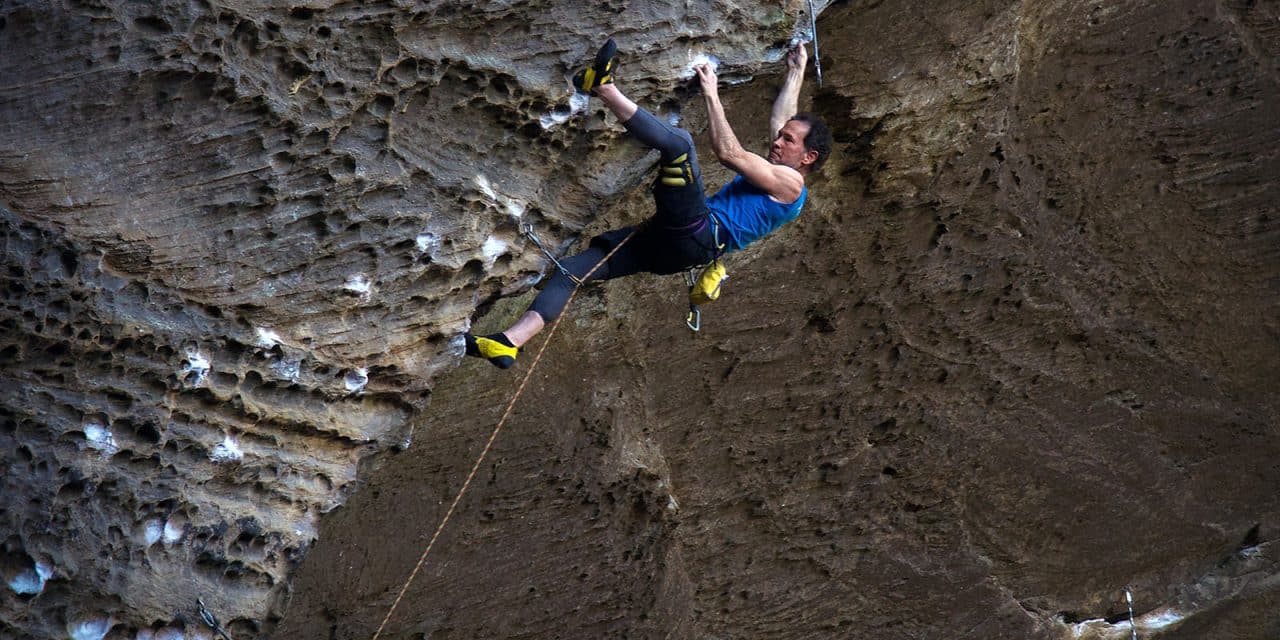
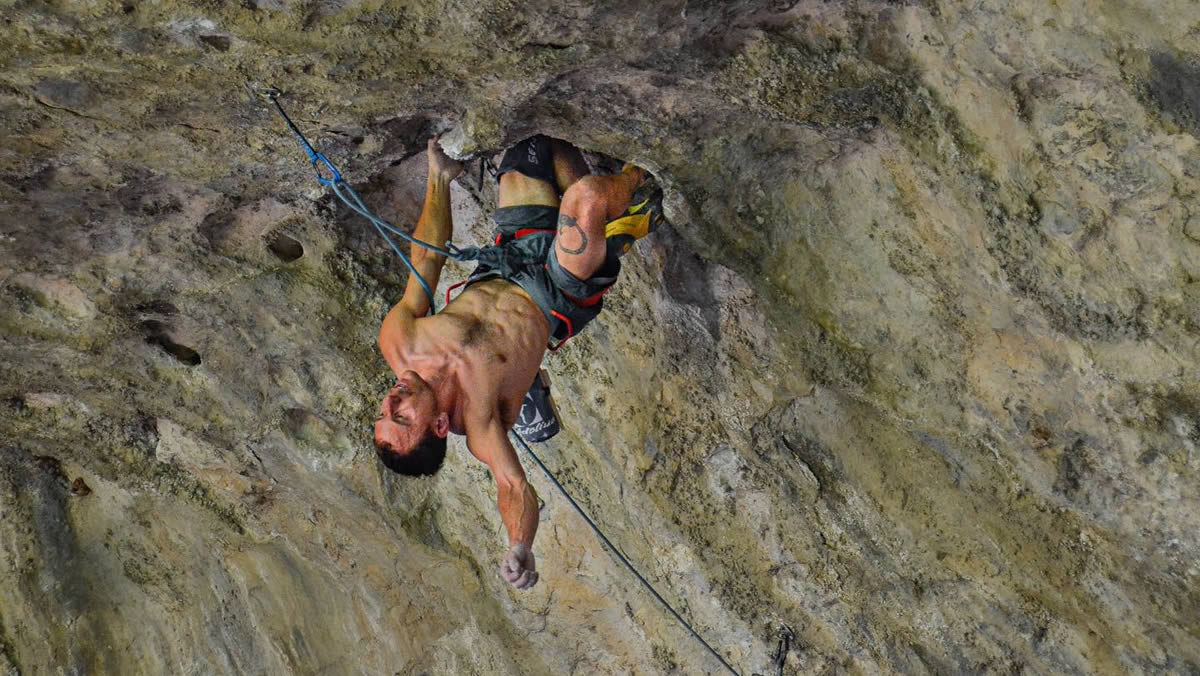
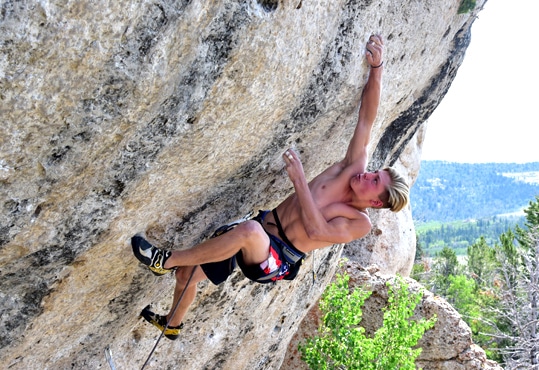

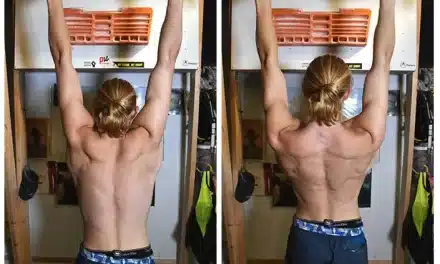

![🚨New Training For Climbing podcast drop! [**Link in bio.**]
This a two-part deep dive into designing a comprehensive, long-term systems approach to training. Coach @eric_horst unpacks—in rich detail—how systems actually function, and he highlights how transformative climbers throughout history “shake up the box” with innovative, highly effective methods to achieve big goals and push the boundaries of our sport.
In Part 1 (#122), Eric blends a concise climbing history lesson with an engineer-like breakdown of how intelligent systems operate. Part 2 (#123) of this series will deliver the actionable strategies you can use to build a personalized, high-performance training system for this winter…and for many seasons to come.
Eric emphasizes that as climbers progress beyond the beginner stage, climbing and training grow increasingly complex—requiring intentional, organized, and year-round development of strength, technique, mental skills, recovery habits, nutrition, and lifestyle management. Rather than ad-lib sessions or singular-focus programs (like only training strength), climbers need a comprehensive system fine-tuned daily and seasonally.
This is an entertaining and thought-provoking episode—so lean in, listen closely, and get ready to feel inspired, challenged, and equipped to level-up your modus operandi at the crag, in the gym, at home, and in everything you do! Listen on Apple Podcasts, Spotify, or online using the web player below.
#climbingtraining #bouldering #indoorclimbing #climbing #climbingpodcast #erichorst #trainingforclimbing @lasportivana @physivantage](https://trainingforclimbing.com/wp-content/plugins/instagram-feed/img/placeholder.png)


